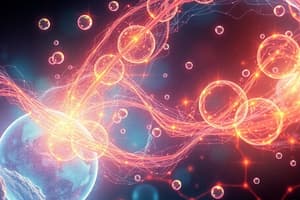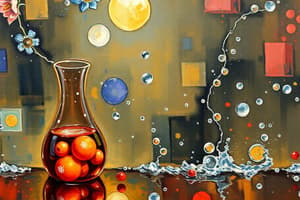Podcast
Questions and Answers
Which technique is primarily used to determine the concentration of an unknown solution?
Which technique is primarily used to determine the concentration of an unknown solution?
- Chromatography
- Colorimetry
- Titration (correct)
- Spectroscopy
Chromatography is used to identify and quantify components of a sample.
Chromatography is used to identify and quantify components of a sample.
False (B)
What is the primary purpose of spectroscopy in chemical analysis?
What is the primary purpose of spectroscopy in chemical analysis?
To identify and quantify components of a sample using electromagnetic radiation.
In atomic absorption spectroscopy (AAS), the absorption of light by _____ is measured.
In atomic absorption spectroscopy (AAS), the absorption of light by _____ is measured.
Match the following chemical analysis techniques with their descriptions:
Match the following chemical analysis techniques with their descriptions:
Which factor does NOT influence the rate of a chemical reaction?
Which factor does NOT influence the rate of a chemical reaction?
Higher temperatures decrease the kinetic energy of particles, resulting in slower reactions.
Higher temperatures decrease the kinetic energy of particles, resulting in slower reactions.
What is the role of a catalyst in a chemical reaction?
What is the role of a catalyst in a chemical reaction?
The primary gases in the atmosphere include nitrogen (N2), oxygen (O2), and __________.
The primary gases in the atmosphere include nitrogen (N2), oxygen (O2), and __________.
Which of the following gases plays a crucial role in the greenhouse effect?
Which of the following gases plays a crucial role in the greenhouse effect?
Match the following atmospheric gases with their role:
Match the following atmospheric gases with their role:
What is the difference between qualitative and quantitative analysis?
What is the difference between qualitative and quantitative analysis?
Acid rain is formed by the reaction of water with carbon dioxide (CO2) in the atmosphere.
Acid rain is formed by the reaction of water with carbon dioxide (CO2) in the atmosphere.
Flashcards
Titration
Titration
A method used to determine the concentration of an unknown solution by reacting it with a solution of known concentration.
Spectroscopy
Spectroscopy
A technique that uses electromagnetic radiation to identify and quantify components of a sample.
Chromatography
Chromatography
Separating components of a mixture based on their different properties (like size, polarity, or boiling point).
Colorimetry
Colorimetry
Signup and view all the flashcards
Atomic Absorption Spectroscopy (AAS)
Atomic Absorption Spectroscopy (AAS)
Signup and view all the flashcards
Rate of Reaction
Rate of Reaction
Signup and view all the flashcards
Catalyst
Catalyst
Signup and view all the flashcards
Nitrogen (N2)
Nitrogen (N2)
Signup and view all the flashcards
Ozone (O3)
Ozone (O3)
Signup and view all the flashcards
Qualitative Analysis
Qualitative Analysis
Signup and view all the flashcards
Quantitative Analysis
Quantitative Analysis
Signup and view all the flashcards
Greenhouse Effect
Greenhouse Effect
Signup and view all the flashcards
Acid Rain
Acid Rain
Signup and view all the flashcards
Study Notes
Rate of Change
- Rate of reaction is the speed at which reactants are converted into products.
- Measured by the change in concentration of a reactant or product per unit time.
- Factors affecting rate:
- Temperature: Higher temperatures increase kinetic energy of particles, leading to more frequent and energetic collisions, thus faster reactions.
- Concentration: Higher concentration increases the number of reactant particles per unit volume, increasing collision frequency and reaction rate.
- Surface area: Larger surface area increases the area of contact between reactants, leading to more frequent collisions and faster reaction rate.
- Catalysts: A catalyst speeds up a reaction without being consumed. It provides an alternative reaction pathway with a lower activation energy.
- Rate equations express the relationship between reaction rate and reactant concentration. The overall order of the reaction is determined by the sum of the orders of individual reactants.
- Different types of reactions have different rate laws.
Chemistry of the Atmosphere
- The atmosphere is a mixture of gases, primarily nitrogen (N2), oxygen (O2), and argon (Ar).
- Important atmospheric gases include:
- Carbon dioxide (CO2): Plays a crucial role in the greenhouse effect.
- Water vapor (H2O): Essential for weather patterns and contributes to the greenhouse effect.
- Ozone (O3): Absorbs harmful UV radiation in the stratosphere, but is a pollutant in the troposphere.
- Atmospheric pollution: Sources include:
- Burning fossil fuels: Releases pollutants like sulfur dioxide (SO2), nitrogen oxides (NOx).
- Industrial processes: Release various pollutants.
- Vehicle emissions: Release pollutants like carbon monoxide (CO), nitrogen oxides (NOx), and unburnt hydrocarbons.
- Atmospheric chemistry studies the chemical processes occurring in the atmosphere:
- Photochemical reactions: Reactions initiated by light absorption, like smog formation.
- Acid rain: Formation caused by the reaction of sulfur oxides and nitrogen oxides with water in the atmosphere.
- Greenhouse effect: The absorption of infrared radiation by greenhouse gases, leading to global warming.
Chemical Analysis
- Techniques for determining the identity and quantity of substances in a sample.
- Qualitative analysis: Identifies the components present in a sample.
- Quantitative analysis: Determines the amount of each component in a sample.
- Common techniques:
- Titration: A technique used to determine the concentration of an unknown solution by reacting it with a solution of known concentration.
- Spectroscopy: Use of electromagnetic radiation to identify and quantify components of a sample. Different types of spectroscopy include UV-Vis, IR, and NMR spectroscopy.
- Chromatography: Separates components of a mixture based on their different properties. Common types include gas chromatography (GC) and high-performance liquid chromatography (HPLC).
- Colorimetry: Measures absorbance of light by a solution to determine the concentration of a colored substance.
- Atomic absorption spectroscopy (AAS): Measures the absorption of light by atoms in a sample (especially metals).
- Common errors in chemical analysis
- Steps to minimizing error
- Importance of safety in chemical analysis techniques
- Precautions while using chemical reagents.
Studying That Suits You
Use AI to generate personalized quizzes and flashcards to suit your learning preferences.




